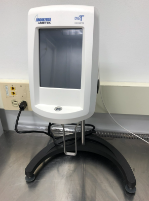Viscometry: Difference between revisions
No edit summary |
(The image is now showing up correctly and I have begun adding text to the page. The SOP is linked above the viscometer image.) |
||
| Line 6: | Line 6: | ||
|[[File:Viscometer.PNG|center|300px]]<!-- THIS IS A COMMENT: insert image .png file here after uploading --> | |[[File:Viscometer.PNG|center|300px]]<!-- THIS IS A COMMENT: insert image .png file here after uploading --> | ||
|- | |- | ||
|''' | |'''Measurement Range''': 15-6,000,000 centipoise (cP) | ||
|- | |- | ||
|'''Spec 2''': Details | |'''Spec 2''': Details | ||
|} | |} | ||
== | ==Viscosity== | ||
Viscosity is a quantity that numerically describes the resistance to flow of a fluid. | |||
==Operation== | ==Operation== | ||
The viscometer rotates a spindle submerged in the fluid of interest through a spring, which measures the drag caused by the fluid. Factors determining the viscosity measurement are the spindle being used (chosen for its size), the container (this viscometer is calibrated for 600 milliliter low-form Griffin beakers), and the speed of the spindle. Prior to starting a test, the user can select a combination of spindle and rotation speed that best suits their needs and the expected viscosity of the fluid being measured. The viscometer will automatically update the maximum viscosity it can accurately measure with the selected parameters as the user changes the options (i.e. selecting a smaller spindle and/or lowering the speed will increase the range). | |||
==Theory== | ==Theory== | ||
Revision as of 23:32, 12 October 2022
| Brookfield DV2T Viscometer [SOP] |
|---|
| Measurement Range: 15-6,000,000 centipoise (cP) |
| Spec 2: Details |
Viscosity
Viscosity is a quantity that numerically describes the resistance to flow of a fluid.
Operation
The viscometer rotates a spindle submerged in the fluid of interest through a spring, which measures the drag caused by the fluid. Factors determining the viscosity measurement are the spindle being used (chosen for its size), the container (this viscometer is calibrated for 600 milliliter low-form Griffin beakers), and the speed of the spindle. Prior to starting a test, the user can select a combination of spindle and rotation speed that best suits their needs and the expected viscosity of the fluid being measured. The viscometer will automatically update the maximum viscosity it can accurately measure with the selected parameters as the user changes the options (i.e. selecting a smaller spindle and/or lowering the speed will increase the range).
Theory
Theory of operation. Feel free to add hyperlinks to other internal pages about the topic (ex. 3D Printing [math]\displaystyle{ \rightarrow }[/math] Additive Manufacturing) or external links as such: Editing pages on Mediawiki.
Subsection 1
Formulae or sidenotes about theory can be placed in subsections. (ex. XRD [math]\displaystyle{ \rightarrow }[/math] Bragg's Law)
Subsection 2
- A LaTeX extension is available on the MILL Wiki.
- Simply enclose your LaTeX in
<math>...</math>
- Simply enclose your LaTeX in
Subsubsection
- To display a monospaced code textbox, use
<code>...</code>- To remove Wiki formatting, use
<nowiki>...</nowiki>
- To remove Wiki formatting, use
Extras
Create a new page
If the page already exists, this will redirect you to the source editor.

